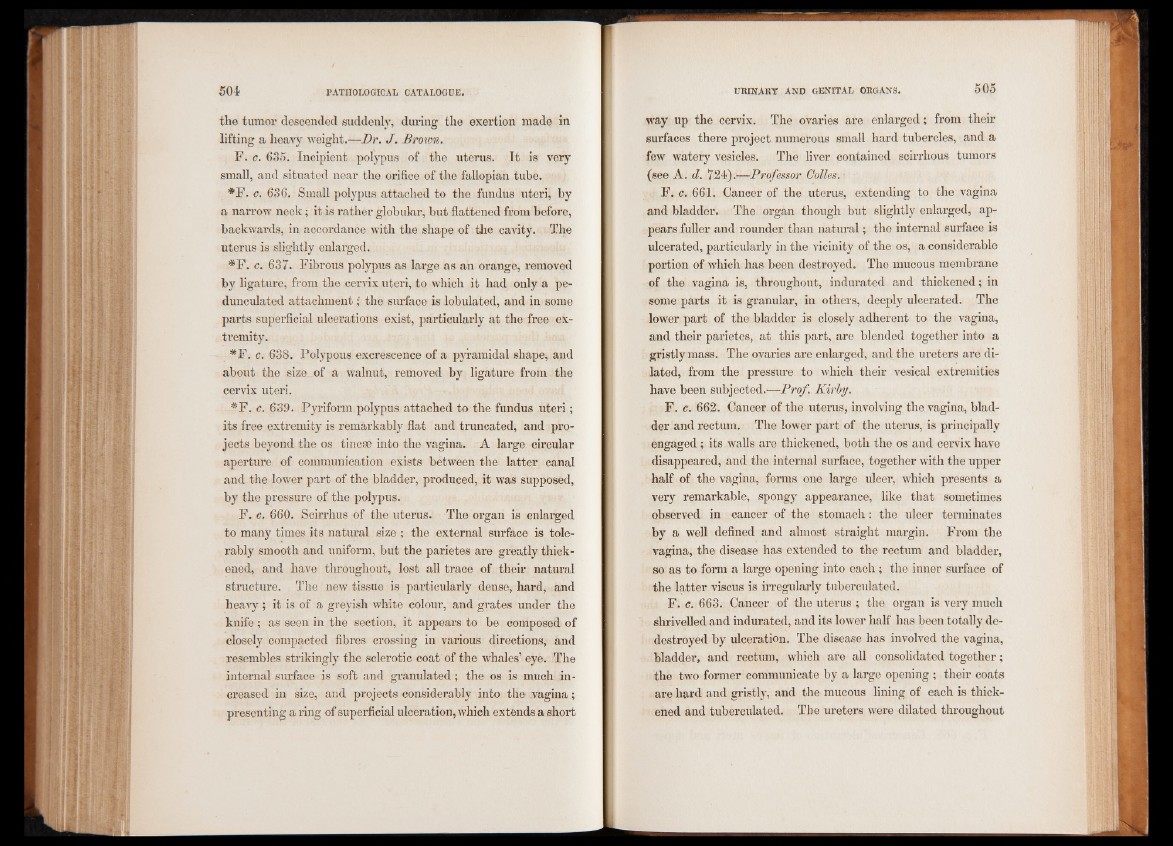
the tumor descended suddenly, during the exertion made in
lifting a heavy weight.—Dr. J. Brown.
F. c. 635. Incipient polypus of the uterus. It is very
small, and situated near the orifice of the fallopian tube.
*F. c. 636. Small polypus attached to the fundus uteri, by
a narrow neck; it is rather globular, but flattened from before,
backwards, in accordance with the shape of the cavity. The
uterus is slightly enlarged.
#F. c. 637. Fibrous polypus as large as an orange, removed
by ligature, from the cervix uteri, to which it had only a pedunculated
attachment; the surface is lobulated, and in some
parts superficial ulcerations exist, particularly at the free extremity.
#F. c. 638. Polypous excrescence of a pyramidal shape, and
about the size, of a walnut, removed by ligature from the
cervix uteri.
#F. c. 639. Pyriform polypus attached to the fundus uteri;
its free extremity is remarkably flat and truncated, and projects
beyond the os tincse into the vagina. A large circular
aperture of communication exists between the latter canal
and the lower part of the bladder, produced, it was supposed,
by the pressure of the polypus.
F. c. 660. Scirrhus of the uterus. The organ is enlarged
to many times its natural size ; the external surface is tolerably
smooth and uniform, but the parietes are greatly thickened,
and have throughout, lost all trace of their natural
structure. The new tissue is particularly dense, hard, and
heavy ; it is of a greyish white colour, and grates under the
knife; as seen in the section, it appears to be composed of
closely compacted fibres crossing in various directions, and
resembles strikingly the sclerotic coat of the whales’ eye. The
internal surface is soft and granulated; the os is much increased
in size, and projects considerably into the vagina;
presenting a ring of superficial ulceration, which extends a short
way up the cervix. The ovaries are enlarged; from their
surfaces there project numerous small hard tubercles, and a
few watery vesicles. The liver contained scirrhous tumors
(see A. d. 724).—Professor Colies. •
F. c. 661. Cancer of the uterus, extending to the vagina
and bladder. The organ though but slightly enlarged, appears
fuller and rounder than natural; the internal surface is
ulcerated, particularly in the vicinity of the os, a considerable
portion of which has been destroyed. The mucous membrane
of the vagina is, throughout, indurated and thickened; in
some parts it is granular, in others, deeply ulcerated. The
lower part of the bladder is closely adherent to the vagina,
and their parietes, at this part, are blended together into a
gristly mass. The ovaries are enlarged, and the ureters are dilated,
from the pressure to which their vesical extremities
have been subjected.—Prof. Kirby.
F. c. 662. Cancer of the uterus, involving the vagina, bladder
and rectum. The lower part of the uterus, is principally
engaged ; its walls are thickened, both the os and cervix have
disappeared, and the internal surface, together with the upper
half of the vagina, forms one large ulcer, which presents a
very remarkable, spongy appearance, like that sometimes
observed in cancer of the stomach : the ulcer terminates
by a well defined and almost straight margin. From the
vagina, the disease has extended to the rectum and bladder,
so as to form a large opening into each ; the inner surface of
the latter viscus is irregularly tuberculated.
F. c. 663. Cancer of the uterus ; the organ is very much
shrivelled and indurated, and its lower half has been totally de-
destroyed by ulceration. The disease has involved the vagina,
bladder, and rectum, which are all consolidated together;
the two former communicate by a large opening ; their coats
are hard and gristly, and the mucous lining of each is thickened
and tuberculated. The ureters were dilated throughout